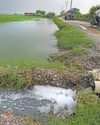
CALL IT a desperate attempt to reduce the soaring import bills since Russia’s war on Ukraine or to achieve self-reliance in fertiliser production and at the same time reduce environmental pollution and farm input costs, India has become the first country to have developed and roll out nano-fertilisers. Since 2021, it has launched nano-variants of two fertilisers widely used in the country—urea and di-ammonia phosphate (DAP). The Indian Farmers Fertiliser Cooperative Limited (IFFCO), which has developed the variants using a proprietary technology, claims that nano-urea and nano-DAP have several advantages over their conventional granular counterparts. The government is promoting the products, saying they can boost soil health as well as farmers’ income. Farmers, however, are not convinced.
Both nano-urea and nano-DAP come in liquid forms. IFFCO claims that a 500-mililitre bottle of nano-urea can replace at least a 45-kg bag of granular urea and a bottle of 500 ml nano-dap can replace a 50 kg bag of granular DAP. While nano-urea has been made available to farmers since late 2021, nano-dap was launched in April 2023. While launching nano-DAP, Union home minister Amit Shah said that as of March 2023, the country manufactured 63 million bottles of nano-urea. As a result, import of urea reduced by 0.7 million tonnes in 2021-22. The goal is now to reduce the usage of granular dap by 9 million tonnes through nano-DAP.
この記事は Down To Earth の June 01, 2023 版に掲載されています。
7 日間の Magzter GOLD 無料トライアルを開始して、何千もの厳選されたプレミアム ストーリー、9,000 以上の雑誌や新聞にアクセスしてください。
すでに購読者です ? サインイン
この記事は Down To Earth の June 01, 2023 版に掲載されています。
7 日間の Magzter GOLD 無料トライアルを開始して、何千もの厳選されたプレミアム ストーリー、9,000 以上の雑誌や新聞にアクセスしてください。
すでに購読者です? サインイン

Lifting a curse
How Gangabai Rajput helped her water-scarce village in Madhya Pradesh let go of superstition and revive an ancient waterbody

CLIMATE SHAPES SPECIES
Gradual changes in a population that lives in a region with environmental shifts give rise to new species

LEAFY GOODNESS
Leaves of the bottle gourd can be a healthy green addition to the plate

'Story of human origin is still not figured out or over'
Fifty years ago, the discovery of a partial skeleton amid the barren desert landscape of northern Ethiopia transformed our understanding of where humans came from, and how we developed into Homo sapiens. \"Lucy\" was first spotted on November 24, 1974, by the American paleoanthropologist Donald Johanson and his student assistant Tom Gray. Named after the Beatles' Lucy in the Sky with Diamonds, a popular song in the their team's camp at the time, it was immediately clear she was a female, because of her small adult size, and that she had walked upright, unlike chimpanzees. Lucy was also very old-at almost 3.2 million years, she was anointed as the then-earliest known (distant) ancestor of modern humans. Over the following decades, rather fittingly given her name, she became a \"paleo-rock star\", going on a US tour from 2006 following a deal with the Ethiopian authorities.

Deadly discharge
Residents of an industrial cluster blame effluent and sewage treatment plants for discharging poorly treated water that contaminates the area, causes skin diseases

US drug regulator faces Trump heat
FAILED REPUBLICAN presidential candidate Vivek Ramaswamy is making more news now than during his doomed attempt to get the party nomination for president. Ramaswamy's decision to throw in the towel and back Donald Trump after his campaign went nowhere showed acumen, the kind he is famous for in the investment world.

Distorted picture
India's groundwater recovery may be misleading, as new assessment methods inflate annual recharge figures and discontinue on-ground verification

A MAKE OR BREAK YEAR
Expect some stiff targets, radical policy measures and rapid innovations as polycrisis reaches a crescendo this year

Commons in crisis
A landmark 2011 Supreme Court ruling to protect shared resources deepens struggles for India's marginalised communities

Europe faces Russian natural gas supply cuts
UKRAINE'S PRIME Minister Denys Shmyhal said on December 16, 2024, that its gas transit agreement with Russia will expire on January 1, 2025, and will not be renewed. The agreement was to allow transit of natural gas to Europe amid the RussiaUkraine conflict.